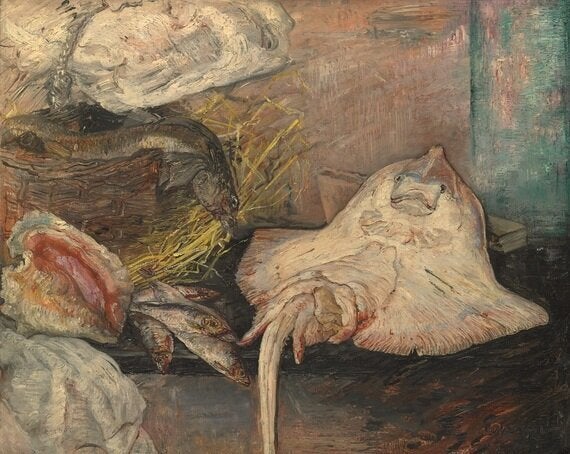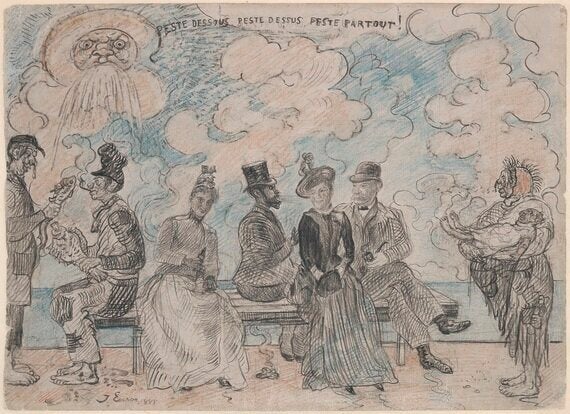
If I were to describe to you images of animate skulls ravenously tearing apart a herring with their teeth, or a living skeleton in a suit putting the finishing touches to a painting, or a crowd laughing together - only each face hidden by a grotesque mask - you'd think the paintings I was describing were dark and foreboding. But these works from James Ensor (1860-1949) are in the brightest colours and the gentlest of pastel palettes. And it's that blend of the macabre and the surreal with lively colours that makes Ensor's works unique.
Ensor is probably Belgium's most celebrated artist of the modern age and one of his most important paintings, The Intrigue, 1890, is included in this new show at the RA, which has been curated by artist Luc Tuymans. Tuymans remembers seeing this painting as a kid. "It was a very fearful thing to look at," Tuymans recalls. Well, even as an adult I feel those chills too.
The painting is a group scene, a lively crowd in their finest clothes heading out to town, only these men and women are all wearing masks. Quite grotesque masks too - eyes blacked out or rolling, and with blood red lips in sinister smiles. The scene is actually based on a Shrove Tuesday tradition from Ostend, where Ensor lived, where residents would mark the last day before Lent by wearing masks in the street. But looking on it with modern eyes, there doesn't feel anything celebratory about this picture. Masks hide faces, they hide intentions and emotions. It's an unsettling image.

Nor is this sense of the surreal macabre confined to this single painting. In this show, Tuymans wanted to demonstrate the unique vision that Ensor had, his risk taking and his experimentation, and he certainly has achieved that with this select display of works in the Sackler Wing. Though whether you would want to stay too long in its galleries, I'm not sure.
Where The Intrigue is a large painting, Skeletons Fighting over a Pickled Herring, 1891, is probably the smallest on display. Here, two skulls are tussling over said herring, the jaws of the skulls clenched down on either end of the fish. Yet, again, the darkness of the subject is in sharp contrast with the pretty pink sky and with one of the skulls wearing a fur hat. It's all very surreal. Yet here Ensor is exhibiting how he feels about the art world, for he is the herring in this picture, being savaged by two art critics who have little care for him.
Ensor felt that his talent was often overlooked by the establishment and this frustrated him. And clearly from above, sometimes the criticism would cut deep. Yet there are instances where Ensor clearly prided himself on his non-conformity - an early self-portrait of him in a flowered hat a precursor perhaps of what was to follow.

There's certainly much to admire in Ensor's style - his free and loose brushwork brings energy to his pieces, especially his still life. A few early paintings see him exploring the popular fashion at the end of the nineteenth century for Chinese paraphernalia, and Ensor's representation of the folds of fans and the delicate patterns in fabric and on porcelain with broad strokes of colour rather than close attention to detail makes for an interesting painting.
And though many of Ensor's paintings are deeply unsettling, irrespective of their perky palettes, there is much humour to be found. A particular favourite of mine is The Skate, 1892. The dead fish lies face up, slumped against the wall at the back of the table. Yet its face seems so alert with its beady eyes and its distinctive mouth. It makes you chuckle; there's something quite cheeky about the painting. Though in others, the humour isn't quite to my personal taste, such as The Winds, 1890, which has God farting across a pretty pink sky.
But some intriguing interiors and still life aside, it is hard to escape the surrealism in Ensor's major works. The oft-used masks are scary and alienating, his skeletons sinister and intimidating. More than draw me in, they pushed me away. Ensor's work is clearly distinctive, and he had an original vision, and I've no doubt that there's some wise observation to be made in his works on what is truthful and what is hidden, but I just found myself backing away from many of the works rather than drawing closer.
Royal Academy of Arts, London, to January 29, 2017
Admission £11.50
Image credits:
1 James Ensor, The Intrigue, 1890 Oil on canvas, 90 x 149 cm Antwerp, Koninklijk Museum voor Schone Kunsten. Photo KMSKA © www.lukasweb.be - Art in Flanders vzw. Photography: Hugo Maertens / (c) DACS 2016
2 James Ensor The Skate, 1892 Oil on panel, 80 x 100 cm Royal Museums of Fine Arts of Belgium, Brussels / photo: J. Geleyns - Ro scan © DACS 2016
3 James Ensor, Plague here, Plague there, Plague Everywhere, 1888 Black, blue and red chalk and graphite on paper, 22.5 x 30 cm Koninklijk Museum voor Schone Kunsten, Antwerp. Photo KMSKA © www.lukasweb.be - Art in Flanders vzw. Photograph: Hugo Maertens / © DACS 2016